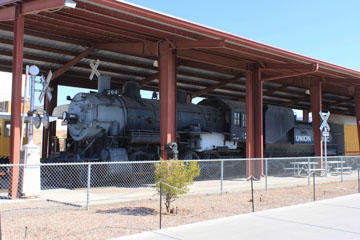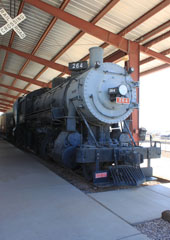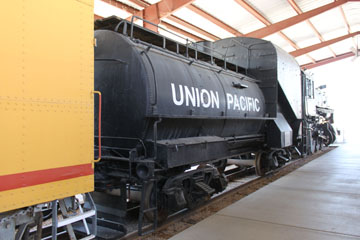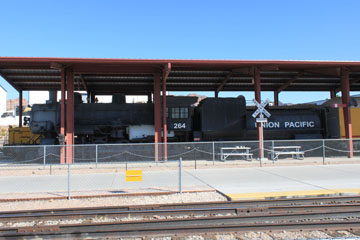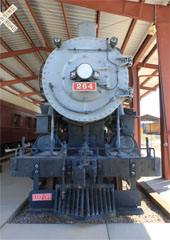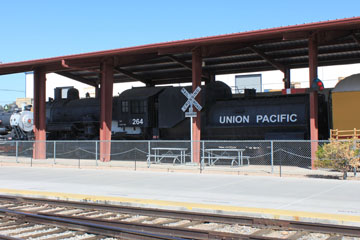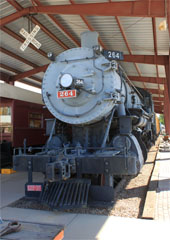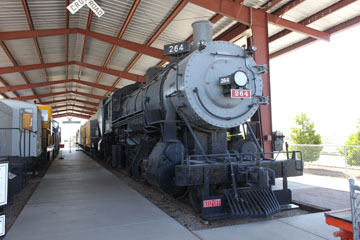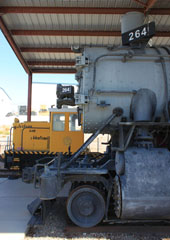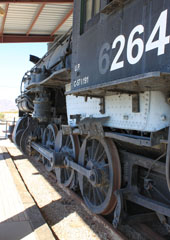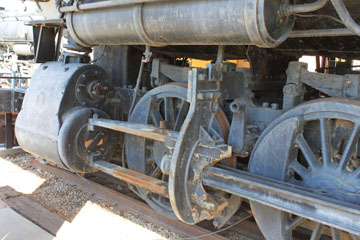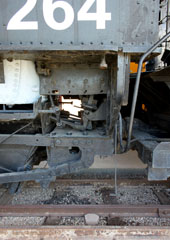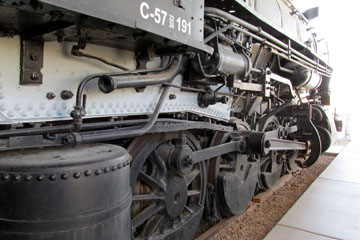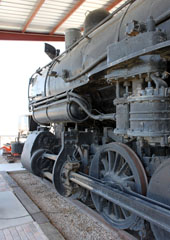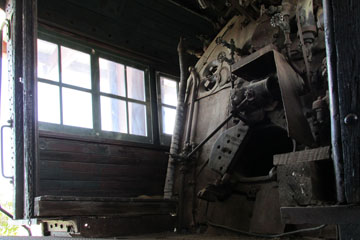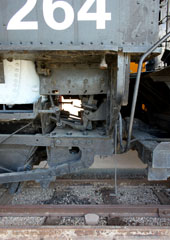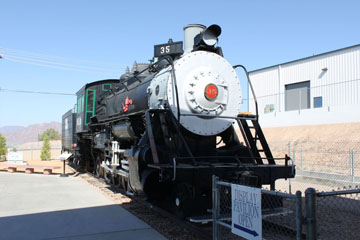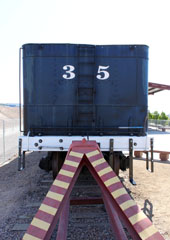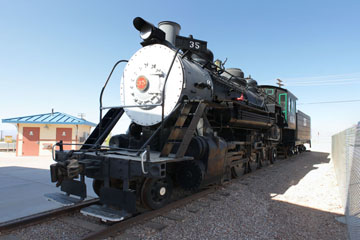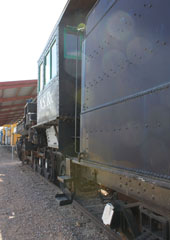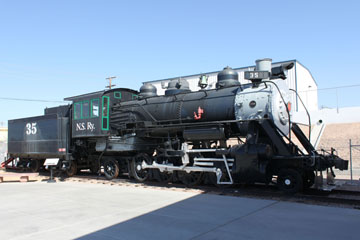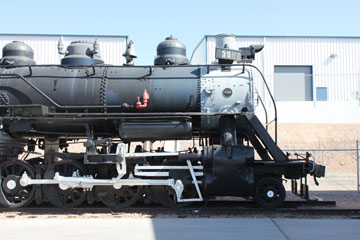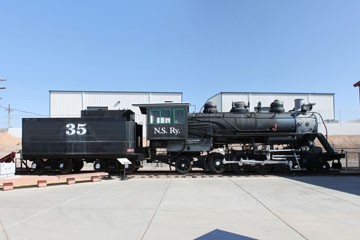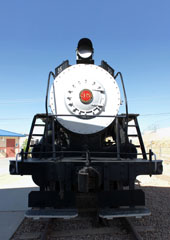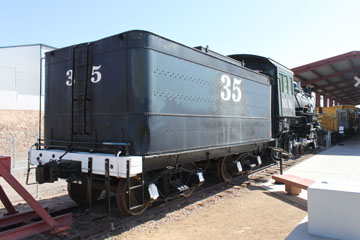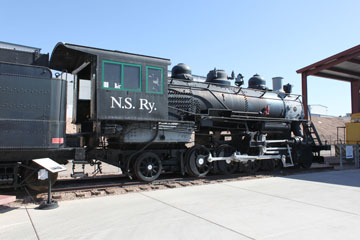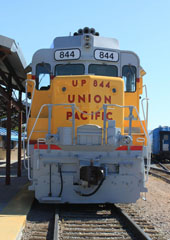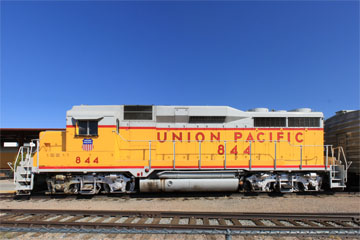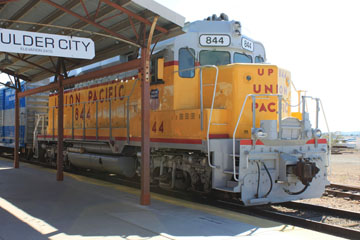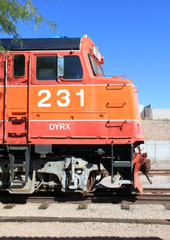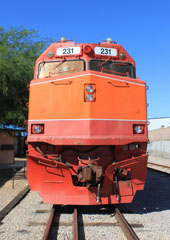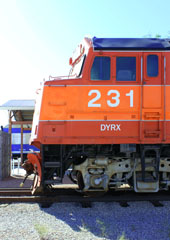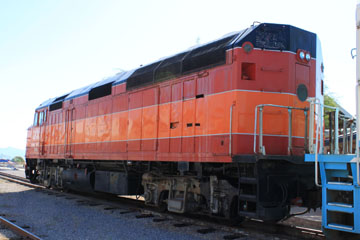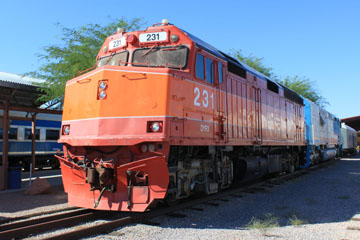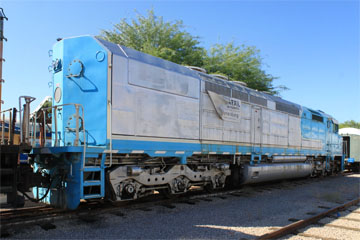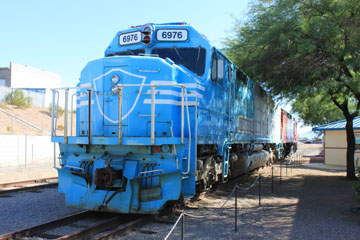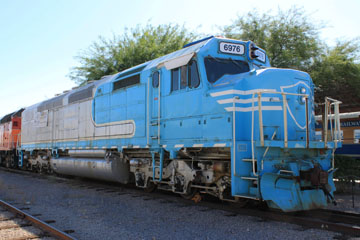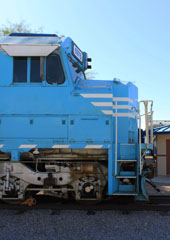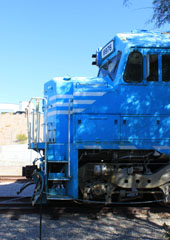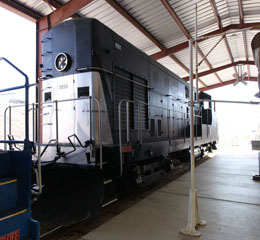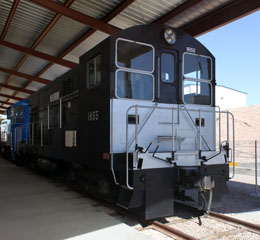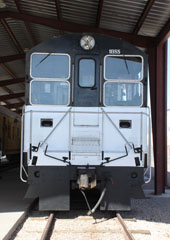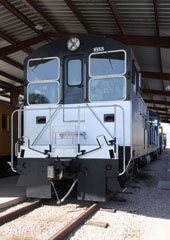

The Nevada State Railroad Museum in Boulder City, NV, is an agency of the Nevada Department of Cultural Affairs. The museum is located at 600 Yucca St.
As well as having a number of locomotives on display, the museum offers forty-five minute passenger excursions on a seven mile line from Boulder City to Henderson, NV, part of a line originally laid in 1931 for construction activities at the Hoover Dam. The state obtained the tracks and right of way from the Union Pacific in 1985. There are also cab rides and one hour sessions operating a diesel engine.

This locomotive was built for the Union Pacific by the Baldwin Locomotive Works in Philadelphia, PA, in 1907 as #264. It is one of three hundred and fifty-eight of what became known as "Harriman Common Standard" Consolidation (2-8-0) type locomotives built for the UP by Baldwin, Brooks and Schenectady from 1904 to 1910.
E. H. Harriman, Chairman of UP's Executive Committee from 1898 until he died in 1909, saw the benefit in building everything from locomotives, dining cars, passenger coaches to cabooses using common standards.
As built, #237 weighed 187,000 lbs. The
Vanderbilt tender weighs 135,050 lbs light and
has a capacity of 7,000 gallons of water and 14
tons of coal. The engine has 57" drivers, Stephenson valve gear and 22" x 30" cylinders. With a 49.5 sq ft grate, 177 sq ft firebox and total heating surface of 3,403 sq ft, it operated at a boiler pressure of 200 psi delivering 43,305 lbs tractive effort.
From 1936, superheaters were fitted to all in-service C-2s when one hundred and seventy-two boiler tubes were replaced by thirty-two flues.
The C-2s were later renumbered into the 6000 series to clear the 200s for the new EMD GP9s. Renumbered #6264, this was one of the last steam locomotives used by the UP. Taken out of service in early 1950, it was stored in La Salle, CO, and then donated to the Sons of the Utah Pioneers in 1959. In 1981, it was relocated to Heber City, UT, and was bought by the Nevada State Railroad Museum in 1993.
You can see other C-2 Class locomotives on the UP #237 page of this website, the UP #616 page and the UP #6051 page.
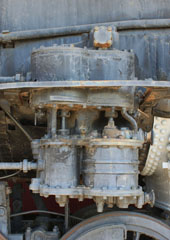

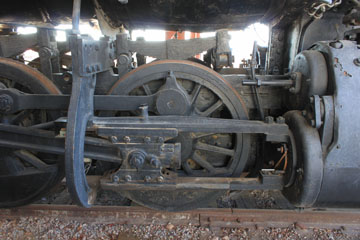
As built, #237 weighed 187,000 lbs. Superheated in 1918, the engine has 57" drivers, Stephenson valve gear and 22" x 30" cylinders, a 49.5 sq ft grate, 190.7 sq ft firebox and total heating surface of 3,273 sq ft including 530 sq ft superheating. It operated at a boiler pressure of 200 psi delivering 43,305 lbs tractive effort. The Vanderbilt tender weighs 135,050 lbs light with a 7,000 gallon water and 14 ton coal capacity.
When the superheater was fitted, the engine weight rose by about 3,000 lbs, but little else changed.
The C-2s were later renumbered into the 6000 series to clear the 200s for the new EMD GP9s. Renumbered #6264, this was one of the last steam locomotives used by the UP. Taken out of service in early 1950, it was stored in La Salle, CO, and then donated to the Sons of the Utah Pioneers in 1959. In 1981, it was relocated to Heber City, UT, and was bought by the Nevada State Railroad Museum in 1993.
You can see other C-2 Class locomotives on the UP #237 page of this website, the UP #616 page and the UP #6051 page.

The tender weighs 90,000 lbs light and
has a capacity of
45,000 gallons of
water and 1,500
gallons of oil.
#35 was sold in 1966
to Edward and Julius Nervo. They, in turn, sold the locomotive to Gunner Henriolle in January 1968.
Built in 1923 by the Baldwin Locomotive Works in Philadelphia, PA, this oil burning Mikado type
(2-8-2) locomotive spent its entire working life with the Pacific Lumber Company in Scotia, CA.
#35 weighs 179,000 lbs, 141,500 lbs on its 48” drivers. It has an engine wheelbase of 27’ 1” and driver wheelbase of 13’ 1”. With a 41.3 sq ft grate, 154 sq ft firebox and total heating surface of 3,029 sq ft, including 553 sq ft superheating, it operated at a boiler pressure of 180 psi delivering 37,507 lbs tractive effort. It is equipped with Walschaert valve gear and has 20½” x 28” cylinders.
In 1972, the locomotive was sold to the
Promontory chapter of the National Railway Historical Society. It was transferred to the Wasatch Railroad & Museum Foundation and operated on the Heber Creeper Scenic Railroad during the 1970s.
Some time during the early 1980s, #35 was taken out of service and placed in storage, where it remained until 1993, when it was sold to the Nevada State Railroad Museum. Note the collared steam and sand domes, an unusual feature for an engine built in 1923.

#844 is an EMD GP30, built for the Union Pacific in 1962.
EMD built nine hundred and forty-eight of this model between 1961 and 1963. The Union Pacific ordered one hundred and fifty-two, seventy-six in the 700 class and seventy-six in the 800.
To achieve a stylistic step change for the GP30, EMD turned to GM’s Automotive Styling Center in Troy, MI, to create the characteristic hump-and-cab profile. This design was necessary to accommodate an electrical cabinet much taller than that used on earlier EMD designs.
The hump started at the rear of the cab, encompassing air intakes for the central air system, and tapered towards the rear of the body. The design also incorporated a low, short hood. A high, short hood could be ordered, but only Norfolk & Western and Southern did so.
Conceived to head off competition from GE's U25B, at 2,500 hp then the highest hp four axle diesel-electric in the US, the GP30 updated elements of the GP20 but managed to get an extra 250 hp out of the 567 series engine.
They were all equipped with 16 cylinder 567D3 prime movers and GM D22 generators driving four GM D57 traction motors. They delivered starting tractive effort of 60,500 lbs at 25% and 50,000 lbs continuous tractive effort at 9.3 mph. At 56' 2" in length, it weighs 260,000 lbs and had a top speed of 65 mph.
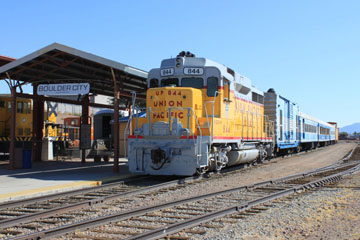
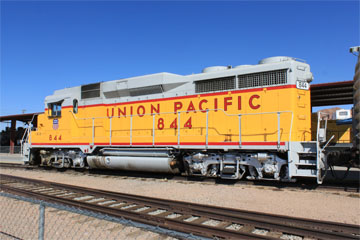
#844 last operated in service in the North Little Rock, AR, area during mid November 1988. The following year, when it was donated to the Nevada State Railroad Museum, it was the last GP30 retired by the UP. It now hauls passenger excursions along 4 miles of track running from the Boulder City Station to Railroad Pass.
The retirement allowed UP's operating FEF-3 4-8-4 steam locomotive to return to its original operating number, #844. It had been renumbered to #8444 in 1962 to avoid conflict with new GP30s 800 class.

Last time I saw #231 it was parked at Union Station, Ogden, UT.
EMD built two hundred and forty-eight of these F40PHR units between 1977 and 1988 at its La Grange, IL, shops for Amtrak. #231 was the second unit outshopped in 1977. It started work out of Chicago, IL, but spent most of its life working out of Los Angeles, CA, hauling the San Diegan, Pacific Surfliner, Coast Starlight, Cascades, Capitol Corridor, San Joaquin, Sunset Limited and Southwest Chief. It was retired in 2001.
The EMD F40PH was built in several different variants by EMD between 1975 and 1992, of which #231 is just one example. The design was based on the EMD GP40 series freight units. The unit is 56’ 2” long and weighs 260,000 lbs. It has a GM 645E3 16 cylinder prime mover powering a 3,000 hp GM AR10 generator to drive four GM D77 traction motors, one on each axle.
The F40PH delivers starting tractive effort of 65,000 lbs at 25% and continuous tractive effort of 38,240 lbs at 16.1 mph and has a top speed of 95 mph.

#6976 was also parked at Union Station when I visited bearing the number #644. It is another project being overseen by Dynamic Rail Preservation, Inc. Like #231, there have been plans to return it to operation in its original AMTK livery
The SDP40F was the first type of locomotive built new for Amtrak. Until then, most of its engines were EMD E and F units inherited from predecessor railroads that had been in service for many years. The design was based on EMD’s SD40-2 freight locomotive.
The SDP40F was mechanically reliable but experienced several high speed derailments, causing the railroads over which Amtrak ran to impose speed limits starting in 1976-77. Then, as the roster of Amtrak F40PHs grew from 1977, the SDP40Fs were progressively retired.
#6976 weighs 265,000 lbs and is 72’ 4” long. A GM 645E3 16 cylinder prime mover powers a GM AR10 generator driving four GM D77 traction motors delivering 65,000 lbs starting tractive effort at 25% and38,240 lbs continuous tractive effort at 16.1 mph, with a top speed of 95 mph.

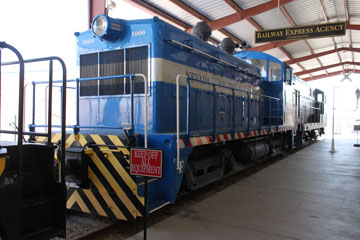
#1000 was built in 1939 as General Motors Corporation #889, a 1,000 hp demonstrator for a new type of yard switching locomotive. It spent its first six months working for the Union Pacific in Omaha, NE. In 1940, the UP bought the unit and renumbered it #1000. It was the first diesel-electric bought by the UP and, over the next two years, the railroad bought another forty-four of the type.
#1000 was sold to the Stockton Terminal &
Eastern Railroad in 1966. In 1968, it was traded to Western Pacific for an Alco switcher where it was renumbered #607 and, the following year,
upgraded to 1,200 hp. It was then sold to the Sacramento Northern in 1973 and spent most of its later years working in the Western Pacific's Stockton, CA, Yard. Sacramento Northern and its corporate parent, the Western Pacific, were absorbed into the UP in 1983 and, in 1984, #607 was donated to the Deer Creek Scenic Railway in Heber City, UT. It was sold to the Nevada State Railroad Museum in 1993.
You can see other NW2s on the Pennsylvania Railroad Museum Yard page of this website, the Virginia Museum of Transportation page and the Monticello Railway Museum page.

Fairbanks Morse had begun supplying opposed piston diesel engines for cab units in 1939. The
H-10-44 switcher began production in 1944, and was, at the time, the most powerful diesel engine available. The H-12-44 followed in 1950, but the locomotives were relatively difficult to maintain and only three hundred and thirty-four H-12-44s were built between 1950 and 1961.
Weighing 246,000 lbs and 49' 2" long, the H-12-44 had an FM 2-cycle 38D8 1/8 (6 cylinder OP) prime mover and Westinghouse WE481G generator powering four Westinghouse WE362B traction motors developing 61,000 lbs starting tractive effort at 25% and 34,000 lbs continuous tractive effort at 8.9 mph. It had a top speed of 60 mph.
Initially, they were slant nosed with a rear roof visor like the FM H-10-44s but, from 1952 as a cost saving exercise, these Raymond Loewy designed features were removed.
You can see other H-12-44s on the Baltimore & Ohio Railroad Yard page of this website, the North Carolina Transportation Museum page, the Museum of the American Railroad page and the Kentucky Railroad Museum page.
#1855 was one of twenty H-12-44 diesel-electrics built by Fairbanks Morse Company of Beloit, WI, and delivered to the Army Transportation Corps in 1950 (#1843-#1862).
Fairbanks Morse had developed a diesel engine used on much of the US Navy's WWII submarine fleet. With two pistons in each cylinder, it generated nearly twice as much power from the same number of cylinders as other engines.

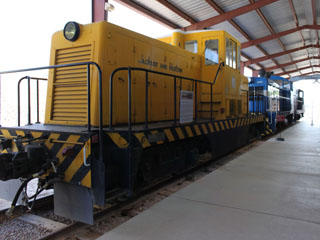
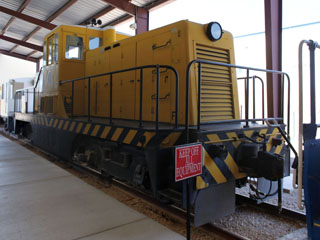
This 80 ton switcher was built by General Electric in 1964. It worked at a US Naval Station as #65-0550 before being
transferred to the Atomic Energy Commission Nevada Test Site where it hauled trains carrying nuclear rocket motors between test stations at the site. When the program became dormant, the locomotive was "mothballed".
The name Jackass & Western comes from "Jackass Flats", one of the locations in which the test site was located.



L-2 is a 150 hp, 25 ton switcher built by General Electric in 1943. It operated at the Atomic Energy Commission Nevada Test Site during the 1960s and 1970s, amongst other duties, hauling nuclear powered rocket engines from site to site. When the program became dormant, the locomotive was "mothballed".
Once the radiation contamination reduced to safe levels, the locomotive was made available to the museum. It arrived on site on 11th November 2010.

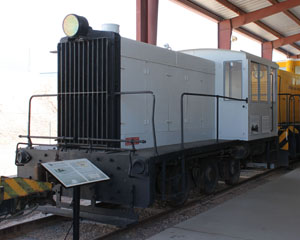
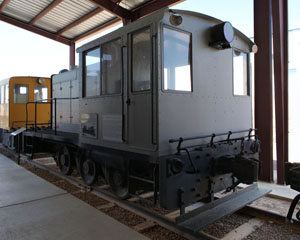
This 250 hp, 30 Ton switcher was built by the Davenport Locomotive Works in Davenport, IA, in 1936 for the Department of the Interior.
It then transferred to the Bureau of Reclamation and worked on the ten mile line connecting Boulder City with the Hoover Dam. Next, it became Henderson Industrial Park #1051 and then went to Jake's Crane & Rigging in Las Vegas, NV, where it was stored until it was delivered to the museum in 1999.


